Author Archives: Sundar Pichai
Optimism for India’s digital future
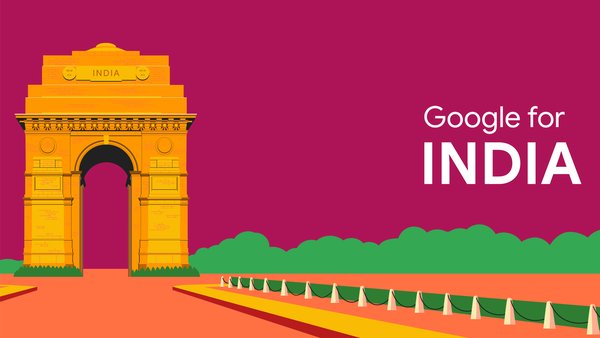 Our CEO reflects on his visit to India and the investments in AI that we shared at our Google for India event to make the country’s digital economy more inclusive, helpf…
Our CEO reflects on his visit to India and the investments in AI that we shared at our Google for India event to make the country’s digital economy more inclusive, helpf…
Source: The Official Google Blog
Optimism for India’s digital future
 Our CEO reflects on his visit to India and the investments in AI that we shared at our Google for India event to make the country’s digital economy more inclusive, helpf…
Our CEO reflects on his visit to India and the investments in AI that we shared at our Google for India event to make the country’s digital economy more inclusive, helpf…
Source: The Official Google Blog
Thoughts on India and technology after receiving the Padma Bhushan
Source: The Official Google Blog
Supporting U.S. food banks to deliver 50 million meals
This week, we kicked off our annual holiday giving campaign. I always look forward to this time of year because it gives Googlers — our employees — a chance to amplify their generosity by directing some of the company’s funds to causes that are important to them and can make an impact in their communities. Every year, food banks, along with schools, are among the most popular recipients for giving back. Our employees have given more than $43 million to U.S. food relief organizations with Google.org’s gift match, as part of our $2 billion in giving since 2017.
This year, food insecurity remains a big challenge for many families across the United States. According to the U.S. Department of Agriculture, more than 10% of Americans were food-insecure at some time in 2021 — meaning they couldn’t be sure that they would have enough food for their family to eat.
One of the best ways to support families is to equip food banks, especially as increasing food prices and global supply chain issues stretch them thin. That’s why today we’re launching a new partnership with Feeding America and its network of local food banks and pantries. Our goal is to deliver 50 million meals, while strengthening food banks’ technical infrastructure for the longer term. We’re also launching new features in Search and Maps that make finding food support easier.
Helping Feeding America
Google.org will contribute $10 million to Feeding America and 32 of its member food banks to help deliver 50 million meals to communities most in need. We’ll partner with these food banks throughout the month to host more than 20 volunteering events in communities across the country, to raise awareness and encourage those who can to give back. In one of those communities, Mesa, Arizona, Google.org has joined forces with Waymo to expand their food rescue program, and Googlers will help load a Waymo Via semi truck full of food to deliver to local food banks. Since May, Waymo Vias have helped transport more than 44,000 pounds of bread on behalf of nonprofits' food rescue efforts.
Google.org is also donating Search advertising to Feeding America and local food banks and pantries across the U.S. in order to connect them with people searching for resources or ways to give back.
Over the longer term, we'll continue to partner with Feeding America on its food bank network's technology infrastructure. This work will help improve things like inventory management tools — projects that are often deprioritized so food banks can meet immediate needs, yet are vital to ensuring that the right food gets to the right households at the right time. We’ll be lending our expertise to help close these gaps, creating volunteer opportunities for Googlers to put their skills to work.
Providing information through our products
One of the biggest ways we can make a difference is by helping people find information about food support in their communities. Last year, we launched Search and Maps features that make it easier to locate verified local food banks. These features also enabled people to find out more about Supplemental Nutrition Assistance Program (SNAP) benefits. And now if you search for "how to apply for SNAP" you can find information about milestones in the application process, including important details on eligibility and documents required.
Once approved for SNAP, many people use Electronic Benefit Transfers (EBT) as a payment method, and you can now search for "EBT" to find your local program's website, check your balance and find contact information to get support. Searching on Google Maps for "grocery stores that accept EBT" surfaces more than 180,000 USDA-approved grocery stores, convenience stores, farmers’ markets and other nearby retailers that accept this payment method.
It will take a sustained and coordinated effort to address the challenge of food insecurity. Working with Feeding America and its partners, we’re committed to raising awareness of this ongoing crisis, and encourage others to help, this holiday season and all year round.
Source: The Official Google Blog
In Tokyo: New commitments to Japan’s digital future
Google opened our first office outside the United States in Shibuya, a neighborhood in Tokyo, back in 2001. Last year marked 20 years in the city — and in the Asia-Pacific region more broadly — and I am excited to be back this week. While here, I helped launch our new Pixel devices and met with leaders to share more about how Google can support Japan’s digital future.
Sundar presenting at the Tokyo Pixel launch.
Something that’s always inspired me on my visits to Japan is how people of all ages are using technology to improve their lives and help others. The last time I was here, I helped open our Campus for Startups, part of our efforts to support generations of entrepreneurs. And today I met with student developers from local universities. Some have already started their own companies, and others are using Pixel and Android to bring their ideas to life.
Our goal is to ensure everyone benefits from the innovation happening in Japan. Today, I was pleased to share the details of our new Japan Digitization Initiative with Prime Minister Kishida. We’re expanding our commitment to build infrastructure, provide digital training and opportunity, and support partners and nonprofits working to bring the benefits of technology to more people.
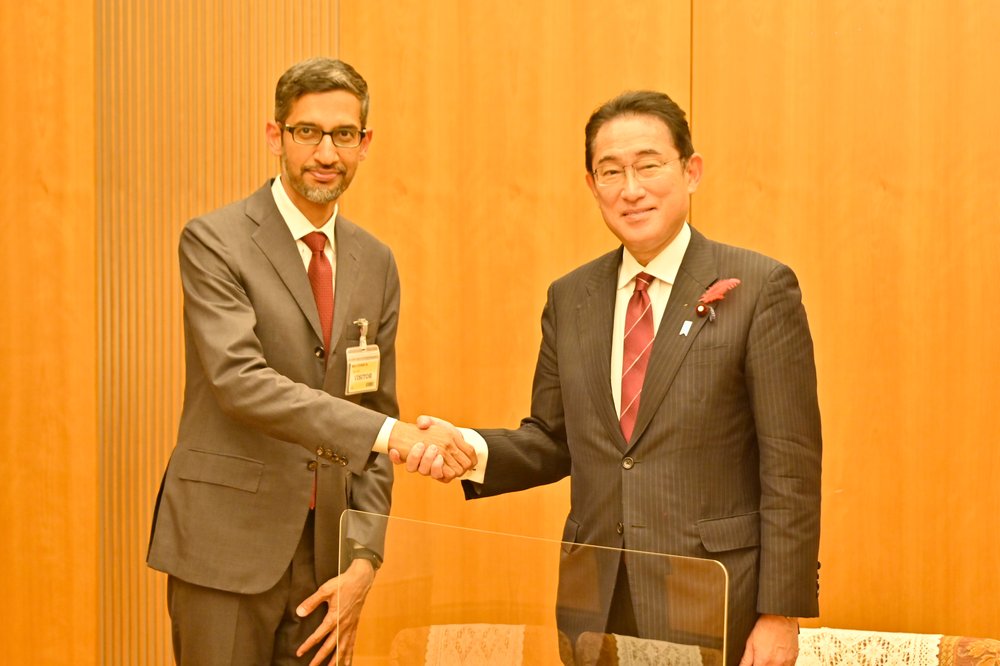
Investing in technical infrastructure
We’ll be opening our first data center in Japan — in Inzai City, Chiba — in 2023. This will give people in Japan faster, more reliable access to our tools and services, support economic activity and jobs, and connect Japan to the rest of the global digital economy.
The Chiba data center is part of a $730 million investment in infrastructure that began last year and will continue through 2024. That includes the Topaz subsea cable, which we expect to be ready for service in 2023, and will become the first fiber cable to connect Japan with the west coast of Canada. Our existing Google Cloud Platform regions, in Tokyo and Osaka, provide storage and services for Japanese businesses. And according to a recent Analysys Mason study, Google’s network infrastructure investments in Japan, both past and present, could enable an additional $303 billion in GDP between 2022 and 2026.
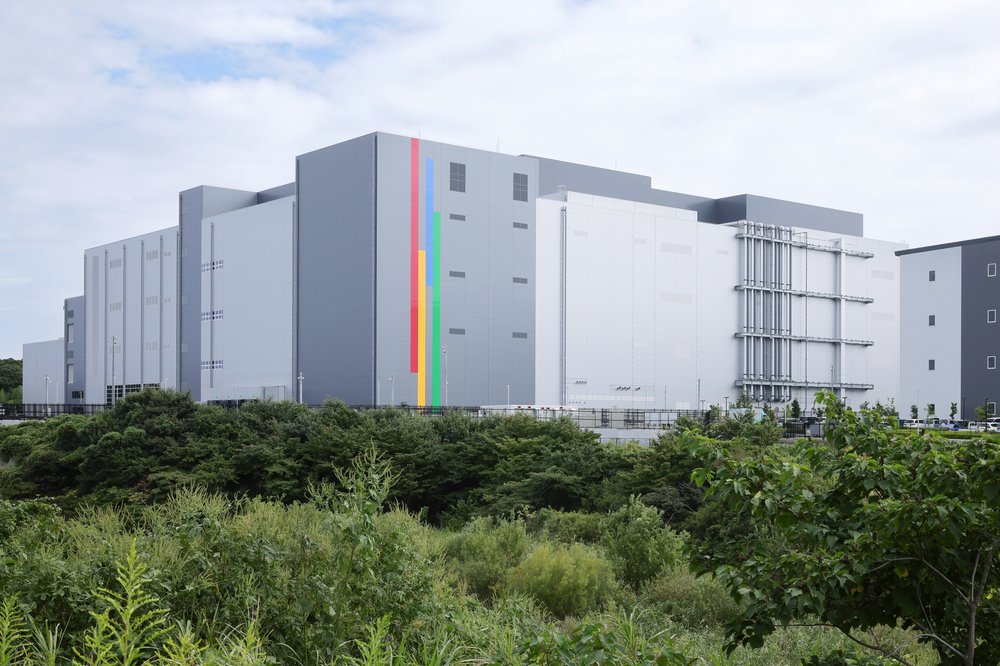
Google’s first data center in Japan is in Inzai City, Chiba Prefecture.
As we build this infrastructure, we’ll keep working to support Japanese businesses in other ways. Our Tokyo startups campus is helping Japanese founders build new kinds of businesses, many motivated by solving social and economic challenges — like helping with health diagnoses or increasing access to education.
Providing digital training and opportunity
We want to help Japanese people learn the skills they need to use technology confidently. Since 2019, we’ve supported 10 million people in Japan through Grow with Google, and adapted our training programs to people and businesses affected by the pandemic.
We’ve seen in Japan and around the world how the pandemic has accelerated the need for skills in specific, high-growth jobs, and we’ve created new kinds of training models to meet the increased demand. That includes the Japan Reskilling Consortium, which we launched in June. It’s a collaboration between business, governments and the nonprofit sector, providing skills training in areas like artificial intelligence and digital marketing and a job-matching service to help trainees find work opportunities. The consortium already offers more than 300 training programs with more than 90 partners.
We’ve also launched a new program to help Japanese companies develop a workplace culture that fosters innovation — with support from Google tailored to different businesses’ needs. We’ll keep building on these initiatives and partnerships from here.
Expanding the benefits of technology
Through Google.org, Google’s philanthropic arm, we’re committing $6 million to support Japanese nonprofits working to expand the benefits of technology.
As part of this effort, we’re providing grant funding to the Japan Foundation for Aging and Health to help them reach 50,000 older people, with a mix of programs focused on digital training, community building and employment support. We’re also supporting the Safer Internet Association in its efforts to increase media literacy in Japanese communities. Other organizations to receive support will be announced soon.
These new commitments complement the important work our teams in Japan do every day. We’ll continue to bring the best of our products, platforms and devices to the millions of Japanese people who use them, from making Google Maps more immersive to helping Japanese developers on Google Play. And we’ll continue our partnerships with Japanese governments and institutions harnessing AI to confront challenges like climate change and disease.
We look forward to helping more people in Japan benefit from the opportunities technology brings, over the decade ahead and beyond.
Source: The Official Google Blog
Building a private sector response to the global refugee crisis
Editor’s note: Tonight our CEO Sundar Pichai received a Global Citizen Awardfrom the Atlantic Council, recognizing Google’s response to the war in Ukraine and support of refugees and displaced people around the world. Below is a video and edited transcript of his remarks delivered in New York City.
I am truly humbled to receive this award. It’s even more meaningful to receive it alongside such an accomplished group of honorees — congratulations to you all.
Above all, tonight we’re here to honor another group that deserves our focus: the people of Ukraine who continue to face unspeakable hardship, and those working tirelessly to help them.
People like Dimitri, an entrepreneur I met based in Kyiv. In 2021, Dimitri founded a startup to provide online mental health services. When the war began, he committed to offer mental health care to all Ukrainians — especially those who can’t afford to pay for it. He’s now reinvesting 100% of his profit towards that goal.
Or people like Tomek, a Polish journalist who shares his passion for science through YouTube. Seeing the disruption the war was causing to kids’ education, he worked with a teacher and interpreter to launch a new, Ukrainian-language science channel. It has meant that children forced to leave Ukraine could use YouTube to keep learning in Poland.
I’m also thinking of 10-year-old Yana, who left Ukraine with her family and enrolled in school in Poland. With the help of Google Translate, she’s made a new best friend, despite the language barrier. Yana and her family are among the 7 million refugees from Ukraine in Europe today.
The need is unprecedented. So is the response. When I was in Warsaw last spring, I was struck by how many Google employees were hosting multiple families in their homes. That was typical in the region, and the generosity continues today.
In the U.S., I’m inspired by the effort to welcome Ukrainian and Afghan newcomers. And again, it’s led by everyday people who are stepping up to help. The private sector can scale these efforts, and fill gaps with technical expertise, resourcing and innovation.
Google has long supported immigrants, Dreamers and refugees. Since 2015, Google has provided more than $45 million in grants and 30,000 hours of our employees’ time to help refugees. We’ve also directly supported refugees and newcomers through our products.
This is a cause that is embedded in Google’s DNA, and it’s one I care deeply about. More than 20 years ago, I immigrated to the U.S. When I arrived, I was met with open-mindedness, tolerance and acceptance — all of which helped ease my path. Looking back on that period of my life, what I remember most are the people who made me feel welcome. Because of them, I started to feel as much a part of this country as I did growing up in India.
It was my choice to come to the U.S. For refugees it’s often not a choice at all. That’s why we need to work even harder to make sure they feel supported on their journey. The opportunity to help more people feel welcome is why I agreed to co-chair the CEO Council for Welcome.US. It’s a nonprofit focused on welcoming Afghan and Ukrainian newcomers to the U.S. And the Council is a broad base of businesses, like Accenture, Amazon, Manpower Group, Pfizer and more.
We’re focused on helping refugees with initial resettlement, matching people with jobs, and raising awareness via our megaphone as business leaders. The goal is to create solutions that can be repeated and scaled. It’s especially important at a time when there are more than 100 million people displaced from their homes, a number that will only grow as the threats of climate change, food security and economic uncertainty increase.
As we build that global response, we have a responsibility to ensure people everywhere can benefit from the opportunities technology creates, be it creating the infrastructure that widens access, advancing technologies that can enable progress, or making sure the internet remains free, open and safe — for everyone.
Across all of this work, it’s important that we are actively addressing the challenges of disinformation, cyber attacks and other harms. Equally, we must also remain optimistic about the power of technology to improve lives.
I’m excited about the partnerships we’ve formed to do that across business, government and civil society — and with the leadership of institutions like the Atlantic Council, those we’ll create in the future. Look forward to working with all of you to expand opportunities and help people feel welcome wherever they are. Thank you.
Source: The Official Google Blog
Bringing computer science education to 11 million students
Earlier this summer, I had the chance to meet alumni of The Hidden Genius Project, an Oakland-based international nonprofit that provides Black male youth with training and mentoring in technology, entrepreneurship and leadership. Many of these graduates had no formal computer science education in their curriculum before joining the organization. Thanks to the technical and coding skills they learned through The Hidden Genius Project, they are now using technology to build their own businesses. One graduate, James, learned how to wire frame, which he’s using to launch an app-based shoe restoration business. Another graduate, Jeremiah, is using the digital skills he learned to increase his company’s online presence and reach more customers for his cleaning services company.
For these young men and for so many other students, computer science (CS) education is providing a foundation in the skills they’ll need for their future careers. Yet there remain deep opportunity gaps in education that prevent everyone from accessing those skills equally.
At Google, we believe educational opportunities should be available regardless of socioeconomic status, background, race or geography. So today, we’re building on our long-time support for nonprofits with an additional $20 million commitment to expand CS education access to more than 11 million students across the U.S. — including more support for The Hidden Genius Project. This brings our total commitment to CS education to more than $240 million since 2004.
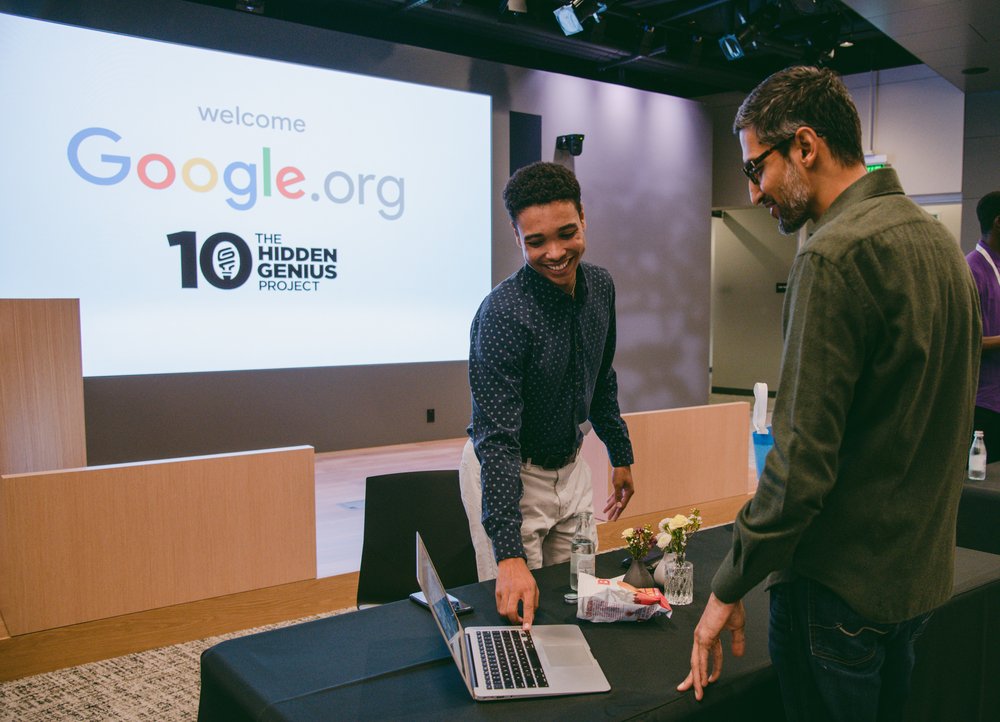
Sundar talks with The Hidden Genius Project alum Ian Bundy-Weiss during the program’s visit to Mountain View in June 2022. Ian founded My Drip, a platform for fashion designers.
We’ll focus our efforts on supporting national and local organizations who reach underserved students in major urban centers and rural communities, and who help governments and educators implement CS education plans nationwide.
In addition to The Hidden Genius Project, we’ll provide support for local nonprofits across the country, with a focus on Atlanta, Chicago, New York, Washington D.C. and Los Angeles. We’re looking forward to helping advance programs like the Computing Integrated Teacher Education project at the City University of New York, to incorporate CS education into the curriculum for new teachers, and supporting CodePath in Chicago and Atlanta, to help students from underrepresented communities work towards tech-based careers.
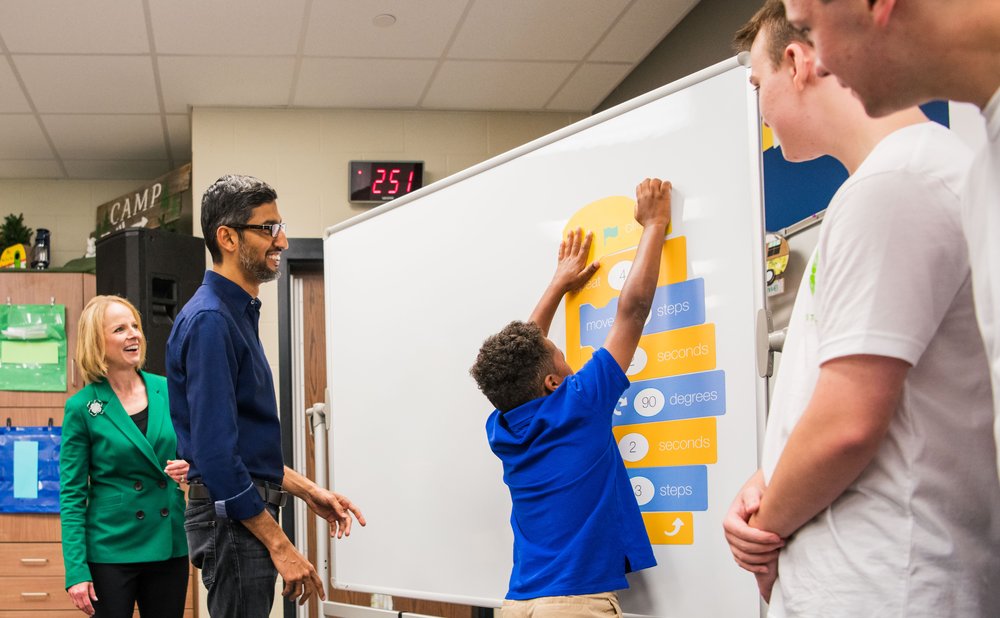
Sundar Pichai and 4-H President and CEO Jennifer Sirangelo join students in a coding activity at a 4-H computer science education event in Mayes County, Oklahoma, in 2019.
To widen access to CS education for students in rural and under-resourced communities, we’re extending our commitment to4-H. With our support, since 2019, 4-H has introduced1.4 million students to CS education pathways, 65% of them in rural communities. The new grant we're providing will support 4-Hers throughCooperative Extension's programs and resources, helping 6 million young people and more than 3,500 educators.
Finally, we’ll provide funding to the Expanding Computing Education Pathways (ECEP) Alliance, a national network coordinated by the Texas Advanced Computing Center at The University of Texas at Austin, which aims to increase participation in CS education through state-level reforms. This funding will enable ECEP to partner with policymakers, educators and others on systemic changes that will help more students from a wider range of backgrounds pursue computing-related degrees. It will also support the addition of five new states to the ECEP Alliance, laying the foundation for a national framework.
Today’s announcement is part of our Grow with Google initiative and includes funding from Google.org. It builds on a lot of other good work underway. Earlier this year, Google partnered with the American Farm Bureau Foundation for Agriculture to train 2,000 teachers on digital skills, enabling them to reach 200,000 rural students by the end of the 2023 school year. And this summer, I joined other CEOs to send a message in support of making computer science a basic part of every K-12 classroom.
Of course, access to computing skills and digital knowledge is important for adults, too. More than 9 million people in the U.S. have already learned new skills through Grow with Google — including Google Career Certificates, which prepare people for jobs in growing fields. We’re building new financing models to extend these programs to more people and drive wage gains for workers. And we’ll continue to partner with organizations to provide local training opportunities, especially in marginalized communities.
We believe Google and other companies have a responsibility to help people get the skills they need to get a good job, start a new business, and provide a solid foundation for their families — no matter what their age or where they live. Computer science education is an important piece of this, and we look forward to working with our partners to unleash the talent and drive of millions of people in communities across the U.S.
Source: The Official Google Blog
Our commitment to Latin America’s digital future
Editor’s note: You can also read this blog inSpanishandPortuguese.
I’ve always believed technology is a powerful enabler for businesses and communities. During the pandemic, we’ve seen how digital tools have helped create jobs and make economies more resilient and sustainable. This is especially true in emerging markets, where an entrepreneurial spirit and new pathways for innovation can unleash enormous economic opportunity.
At Google, we see that potential today in Latin America. Communities have been hit hard by the pandemic, and closing digital access gaps will be vital to an inclusive recovery. At the same time, according to a new report from the Economist, increased investment and a policy focus on AI technologies can unlock new opportunities, from health care and sustainable agriculture to financial services and more.
As we shared in our Digital Sprinters report, digital transformation will require investment by governments and the private sector in infrastructure, people, technological innovation and public policies. In Latin America, realizing the full potential of digital technologies could generate an annual economic impact of up to $1.37 trillion by 2030 in six of the region’s largest economies, or 23% of these countries’ combined GDPs.
We’ve been investing in Latin America over the last 17 years, and today we’re announcing a five-year, $1.2 billion commitment to the region. We will focus on four areas where we believe we can best help the region to thrive: digital infrastructure, digital skills, entrepreneurship and inclusive, sustainable communities.
Investing in digital infrastructure
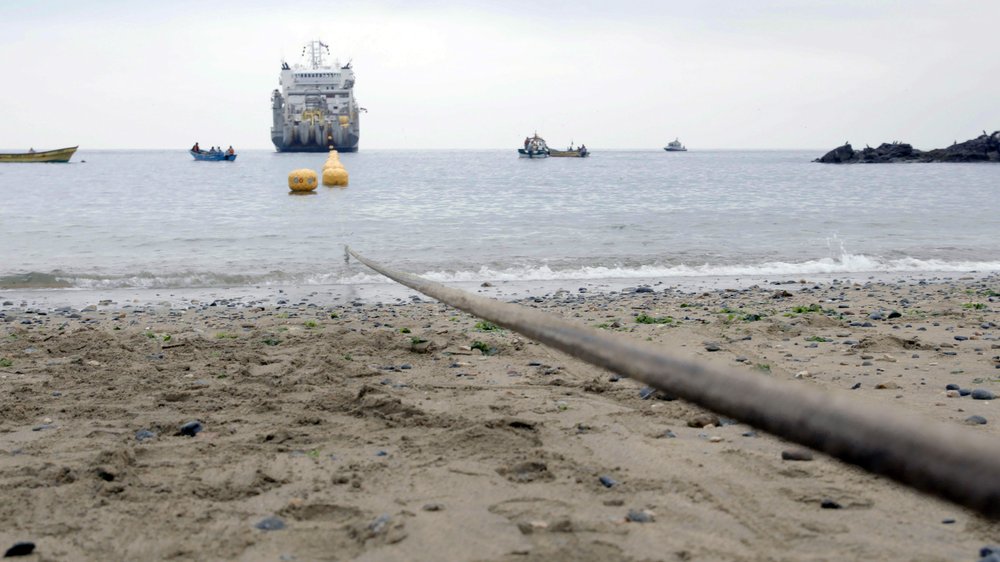
Curie landed in Valparaíso, Chile in 2019 and was the first subsea cable to connect to Chile in 19 years.
We’ve been investing to improve connectivity and increase Latin America’s access to digital services, including Google products like Search, Gmail and YouTube, as well as Google Cloud. The Firmina subsea cable, named after Brazilian abolitionist Maria Firmina dos Reis, will be the world's largest subsea cable, capable of operating from a single power source at one end of the cable if needed. When completed in 2023, it will run from the U.S. to Argentina, with additional landings in Brazil and Uruguay. Firmina follows three other significant cable investments in Latin America — Monet, Tannat and Curie — which together bring more reliable connectivity to the region.
Our Google Cloud Regions in Santiago, Chile, and São Paulo, Brazil, are giving businesses access to compute power and services that enable them to succeed in the digital economy. For example, Tembici, a Brazilian startup that offers bike sharing services in major cities across Latin America, runs its operations on Google Cloud — supporting its regional expansion.
Looking ahead, our Cloud Regions will continue to help more organizations accelerate their digital transformation and build towards long-term growth. We will also increase our engineering footprint in Brazil. These new roles — with a focus on essential areas like privacy and security — will help us create better products for the region and the world.
Expanding opportunity through digital skills
Digital skills are key to unlocking opportunities for the next generation. Through our Grow with Google program and Google.org grantees, we’ve trained nearly eight million people across Latin America in digital skills since 2017.
To build on this momentum, today we’re announcing that we’ll provide Google Career Certificate scholarships to one million people in Latin America. This training will help people access well-paying jobs in high-growth fields.
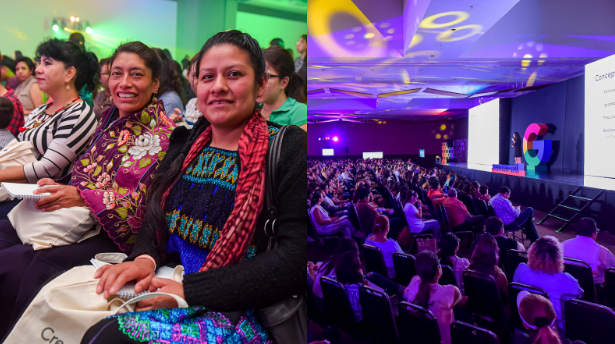
Our Grow with Google program has trained nearly eight million people in Latin American in digital skills since 2017.
Supporting startups and small businesses
There is huge momentum behind tech entrepreneurship throughout Latin America. When we opened our Google for Startups campus in Brazil in 2016, there were no “unicorns,” startups valued at $1 billion or more, in the region. Today, there are 35, including 13 unicorns that have been part of Google for Startups programs. With investment, resources and training from Google for Startups, we have supported more than 450 startups in the region. These startups have gone on to raise more than $9 billion in investments, creating 25,000 jobs.
One example is Oliver Pets, an Argentinian startup that, with support from Google for Startups, was able to launch virtual veterinary care through their app and expand to Mexico and other parts of Latin America.
We’re also seeing how our products and services are helping small businesses thrive in difficult times. When Fátima Álvarez, the co-founder of Mexican startup Someone Somewhere, closed her retail shops during the pandemic, she turned to digital tools like Google Workspace and Google Ads to keep her clothing business running online.
Building more inclusive and sustainable communities
Through our philanthropic arm, Google.org, we’ve been supporting organizations like Laboratoria in Peru, Asociación Colnodo in Colombia and Instituto Rede Mulher Empreendedora in Brazil to make sure underserved communities also benefit from digital transformation.
Today Google.org is announcing $300 million over the next five years, comprised of $50 million in cash grants and $250 million in donated ads, to support nonprofits focused on areas like sustainability and economic opportunity for women and young people. For example, a $2 million Google.org grant to Pro Mujer will help Indigenous women-led businesses in Guatemala, El Salvador and Honduras access microloans and digital skills training.

Through Google.org, we’ve supported Laboratoria, a nonprofit in Peru, to help women access digital skills training.
Across these commitments, we are partnering with governments, entrepreneurs and businesses to support sustainable, resilient and equitable growth. It’s exciting to see Latin America emerge as a hub of innovation, and we look forward to creating even more economic opportunities for those who call it home.
Source: The Official Google Blog
Google I/O 2022: Advancing knowledge and computing
[TL;DR]
Nearly 24 years ago, Google started with two graduate students, one product, and a big mission: to organize the world’s information and make it universally accessible and useful. In the decades since, we’ve been developing our technology to deliver on that mission.
The progress we've made is because of our years of investment in advanced technologies, from AI to the technical infrastructure that powers it all. And once a year — on my favorite day of the year :) — we share an update on how it’s going at Google I/O.
Today, I talked about how we’re advancing two fundamental aspects of our mission — knowledge and computing — to create products that are built to help. It’s exciting to build these products; it’s even more exciting to see what people do with them.
Thank you to everyone who helps us do this work, and most especially our Googlers. We are grateful for the opportunity.
- Sundar
Editor’s note: Below is an edited transcript of Sundar Pichai's keynote address during the opening of today's Google I/O Developers Conference.
Hi, everyone, and welcome. Actually, let’s make that welcome back! It’s great to return to Shoreline Amphitheatre after three years away. To the thousands of developers, partners and Googlers here with us, it’s great to see all of you. And to the millions more joining us around the world — we’re so happy you’re here, too.
Last year, we shared how new breakthroughs in some of the most technically challenging areas of computer science are making Google products more helpful in the moments that matter. All this work is in service of our timeless mission: to organize the world's information and make it universally accessible and useful.
I'm excited to show you how we’re driving that mission forward in two key ways: by deepening our understanding of information so that we can turn it into knowledge; and advancing the state of computing, so that knowledge is easier to access, no matter who or where you are.
Today, you'll see how progress on these two parts of our mission ensures Google products are built to help. I’ll start with a few quick examples. Throughout the pandemic, Google has focused on delivering accurate information to help people stay healthy. Over the last year, people used Google Search and Maps to find where they could get a COVID vaccine nearly two billion times.

Google’s flood forecasting technology sent flood alerts to 23 million people in India and Bangladesh last year.
We’ve also expanded our flood forecasting technology to help people stay safe in the face of natural disasters. During last year’s monsoon season, our flood alerts notified more than 23 million people in India and Bangladesh. And we estimate this supported the timely evacuation of hundreds of thousands of people.
In Ukraine, we worked with the government to rapidly deploy air raid alerts. To date, we’ve delivered hundreds of millions of alerts to help people get to safety. In March I was in Poland, where millions of Ukrainians have sought refuge. Warsaw’s population has increased by nearly 20% as families host refugees in their homes, and schools welcome thousands of new students. Nearly every Google employee I spoke with there was hosting someone.
Adding 24 more languages to Google Translate
In countries around the world, Google Translate has been a crucial tool for newcomers and residents trying to communicate with one another. We’re proud of how it’s helping Ukrainians find a bit of hope and connection until they are able to return home again.
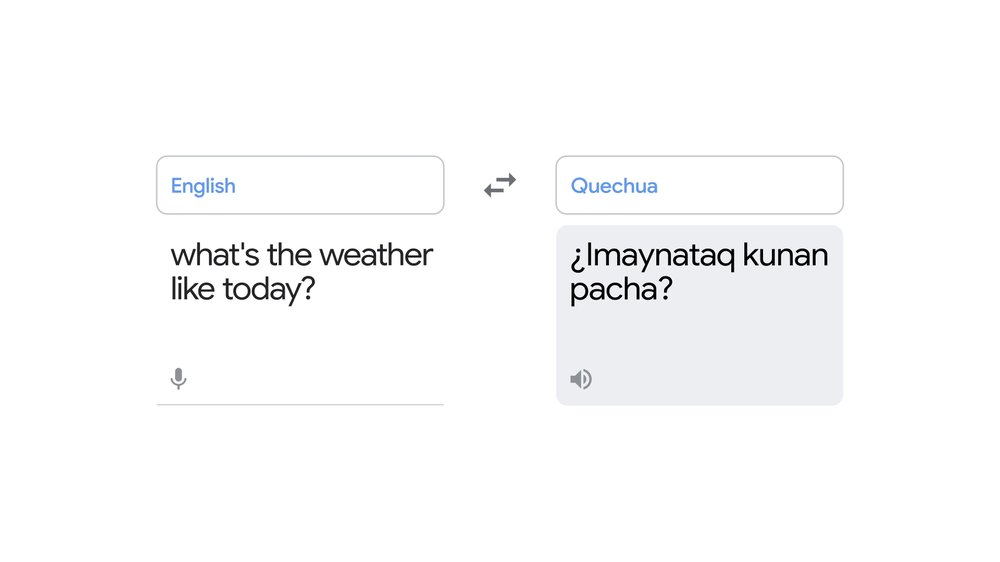
With machine learning advances, we're able to add languages like Quechua to Google Translate.
Real-time translation is a testament to how knowledge and computing come together to make people's lives better. More people are using Google Translate than ever before, but we still have work to do to make it universally accessible. There’s a long tail of languages that are underrepresented on the web today, and translating them is a hard technical problem. That’s because translation models are usually trained with bilingual text — for example, the same phrase in both English and Spanish. However, there's not enough publicly available bilingual text for every language.
So with advances in machine learning, we’ve developed a monolingual approach where the model learns to translate a new language without ever seeing a direct translation of it. By collaborating with native speakers and institutions, we found these translations were of sufficient quality to be useful, and we'll continue to improve them.
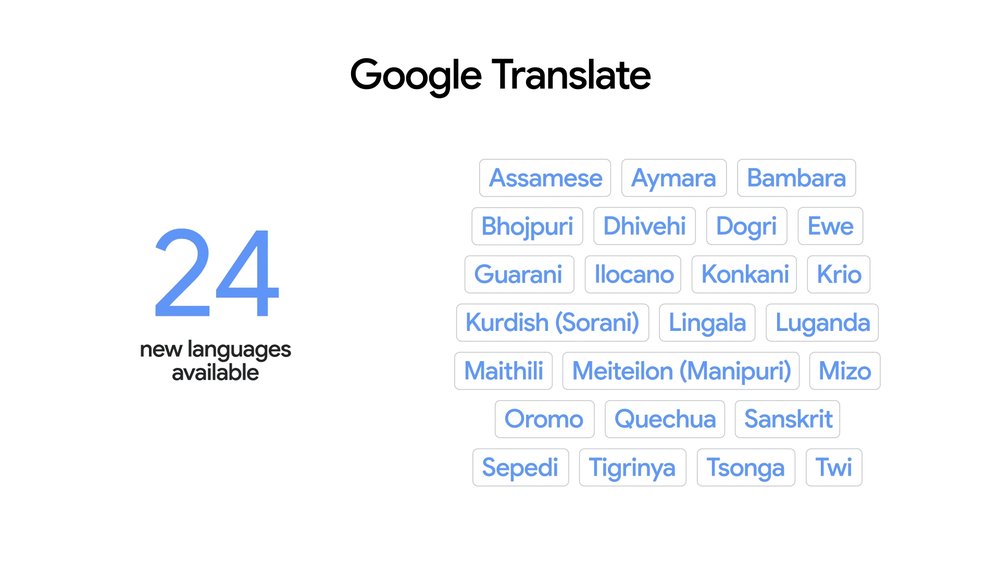
We’re adding 24 new languages to Google Translate.
Today, I’m excited to announce that we’re adding 24 new languages to Google Translate, including the first indigenous languages of the Americas. Together, these languages are spoken by more than 300 million people. Breakthroughs like this are powering a radical shift in how we access knowledge and use computers.
Taking Google Maps to the next level
So much of what’s knowable about our world goes beyond language — it’s in the physical and geospatial information all around us. For more than 15 years, Google Maps has worked to create rich and useful representations of this information to help us navigate. Advances in AI are taking this work to the next level, whether it’s expanding our coverage to remote areas, or reimagining how to explore the world in more intuitive ways.
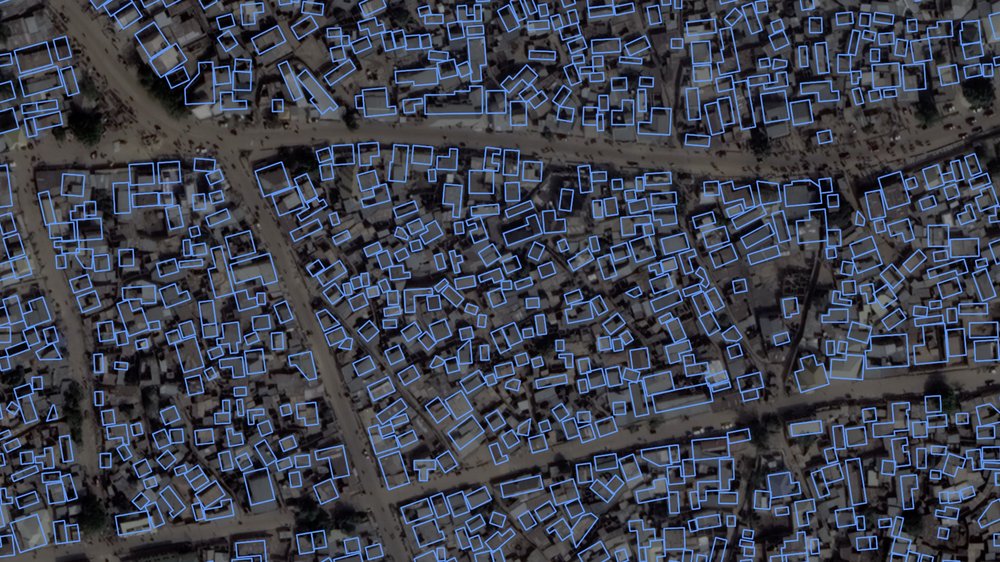
Advances in AI are helping to map remote and rural areas.
Around the world, we’ve mapped around 1.6 billion buildings and over 60 million kilometers of roads to date. Some remote and rural areas have previously been difficult to map, due to scarcity of high-quality imagery and distinct building types and terrain. To address this, we’re using computer vision and neural networks to detect buildings at scale from satellite images. As a result, we have increased the number of buildings on Google Maps in Africa by 5X since July 2020, from 60 million to nearly 300 million.
We’ve also doubled the number of buildings mapped in India and Indonesia this year. Globally, over 20% of the buildings on Google Maps have been detected using these new techniques. We’ve gone a step further, and made the dataset of buildings in Africa publicly available. International organizations like the United Nations and the World Bank are already using it to better understand population density, and to provide support and emergency assistance.
Immersive view in Google Maps fuses together aerial and street level images.
We’re also bringing new capabilities into Maps. Using advances in 3D mapping and machine learning, we’re fusing billions of aerial and street level images to create a new, high-fidelity representation of a place. These breakthrough technologies are coming together to power a new experience in Maps called immersive view: it allows you to explore a place like never before.
Let’s go to London and take a look. Say you’re planning to visit Westminster with your family. You can get into this immersive view straight from Maps on your phone, and you can pan around the sights… here’s Westminster Abbey. If you’re thinking of heading to Big Ben, you can check if there's traffic, how busy it is, and even see the weather forecast. And if you’re looking to grab a bite during your visit, you can check out restaurants nearby and get a glimpse inside.
What's amazing is that isn't a drone flying in the restaurant — we use neural rendering to create the experience from images alone. And Google Cloud Immersive Stream allows this experience to run on just about any smartphone. This feature will start rolling out in Google Maps for select cities globally later this year.
Another big improvement to Maps is eco-friendly routing. Launched last year, it shows you the most fuel-efficient route, giving you the choice to save money on gas and reduce carbon emissions. Eco-friendly routes have already rolled out in the U.S. and Canada — and people have used them to travel approximately 86 billion miles, helping save an estimated half million metric tons of carbon emissions, the equivalent of taking 100,000 cars off the road.
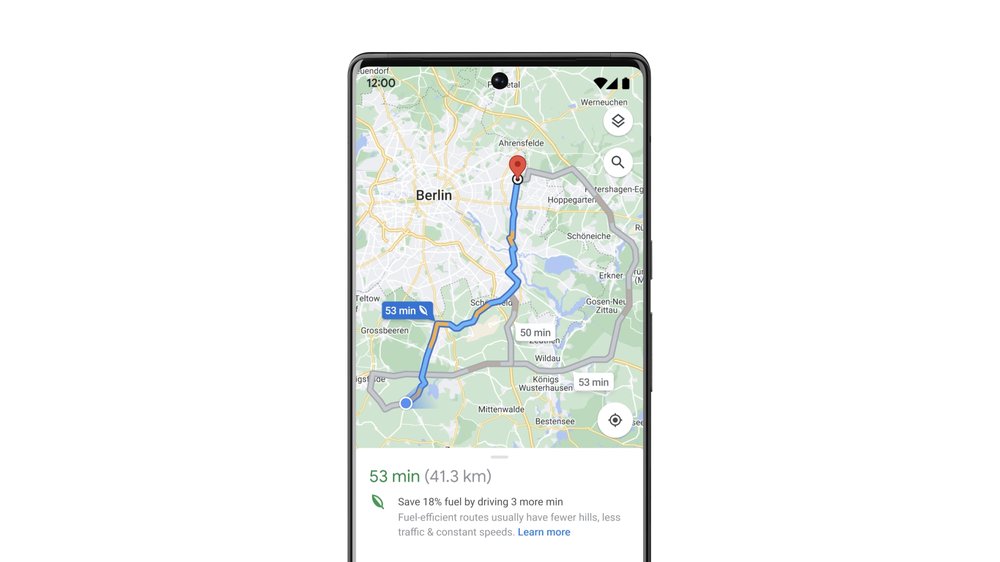
Eco-friendly routes will expand to Europe later this year.
I’m happy to share that we’re expanding this feature to more places, including Europe later this year. In this Berlin example, you could reduce your fuel consumption by 18% taking a route that’s just three minutes slower. These small decisions have a big impact at scale. With the expansion into Europe and beyond, we estimate carbon emission savings will double by the end of the year.
And we’ve added a similar feature to Google Flights. When you search for flights between two cities, we also show you carbon emission estimates alongside other information like price and schedule, making it easy to choose a greener option. These eco-friendly features in Maps and Flights are part of our goal to empower 1 billion people to make more sustainable choices through our products, and we’re excited about the progress here.
New YouTube features to help people easily access video content
Beyond Maps, video is becoming an even more fundamental part of how we share information, communicate, and learn. Often when you come to YouTube, you are looking for a specific moment in a video and we want to help you get there faster.
Last year we launched auto-generated chapters to make it easier to jump to the part you’re most interested in.
This is also great for creators because it saves them time making chapters. We’re now applying multimodal technology from DeepMind. It simultaneously uses text, audio and video to auto-generate chapters with greater accuracy and speed. With this, we now have a goal to 10X the number of videos with auto-generated chapters, from eight million today, to 80 million over the next year.
Often the fastest way to get a sense of a video’s content is to read its transcript, so we’re also using speech recognition models to transcribe videos. Video transcripts are now available to all Android and iOS users.

Auto-translated captions on YouTube.
Next up, we’re bringing auto-translated captions on YouTube to mobile. Which means viewers can now auto-translate video captions in 16 languages, and creators can grow their global audience. We’ll also be expanding auto-translated captions to Ukrainian YouTube content next month, part of our larger effort to increase access to accurate information about the war.
Helping people be more efficient with Google Workspace
Just as we’re using AI to improve features in YouTube, we’re building it into our Workspace products to help people be more efficient. Whether you work for a small business or a large institution, chances are you spend a lot of time reading documents. Maybe you’ve felt that wave of panic when you realize you have a 25-page document to read ahead of a meeting that starts in five minutes.
At Google, whenever I get a long document or email, I look for a TL;DR at the top — TL;DR is short for “Too Long, Didn’t Read.” And it got us thinking, wouldn’t life be better if more things had a TL;DR?
That’s why we’ve introduced automated summarization for Google Docs. Using one of our machine learning models for text summarization, Google Docs will automatically parse the words and pull out the main points.
This marks a big leap forward for natural language processing. Summarization requires understanding of long passages, information compression and language generation, which used to be outside of the capabilities of even the best machine learning models.
And docs are only the beginning. We’re launching summarization for other products in Workspace. It will come to Google Chat in the next few months, providing a helpful digest of chat conversations, so you can jump right into a group chat or look back at the key highlights.

We’re bringing summarization to Google Chat in the coming months.
And we’re working to bring transcription and summarization to Google Meet as well so you can catch up on some important meetings you missed.
Visual improvements on Google Meet
Of course there are many moments where you really want to be in a virtual room with someone. And that’s why we continue to improve audio and video quality, inspired by Project Starline. We introduced Project Starline at I/O last year. And we’ve been testing it across Google offices to get feedback and improve the technology for the future. And in the process, we’ve learned some things that we can apply right now to Google Meet.
Starline inspired machine learning-powered image processing to automatically improve your image quality in Google Meet. And it works on all types of devices so you look your best wherever you are.

Machine learning-powered image processing automatically improves image quality in Google Meet.
We’re also bringing studio quality virtual lighting to Meet. You can adjust the light position and brightness, so you’ll still be visible in a dark room or sitting in front of a window. We’re testing this feature to ensure everyone looks like their true selves, continuing the work we’ve done with Real Tone on Pixel phones and the Monk Scale.
These are just some of the ways AI is improving our products: making them more helpful, more accessible, and delivering innovative new features for everyone.

Today at I/O Prabhakar Raghavan shared how we’re helping people find helpful information in more intuitive ways on Search.
Making knowledge accessible through computing
We’ve talked about how we’re advancing access to knowledge as part of our mission: from better language translation to improved Search experiences across images and video, to richer explorations of the world using Maps.
Now we’re going to focus on how we make that knowledge even more accessible through computing. The journey we’ve been on with computing is an exciting one. Every shift, from desktop to the web to mobile to wearables and ambient computing has made knowledge more useful in our daily lives.
As helpful as our devices are, we’ve had to work pretty hard to adapt to them. I’ve always thought computers should be adapting to people, not the other way around. We continue to push ourselves to make progress here.
Here’s how we’re making computing more natural and intuitive with the Google Assistant.
Introducing LaMDA 2 and AI Test Kitchen
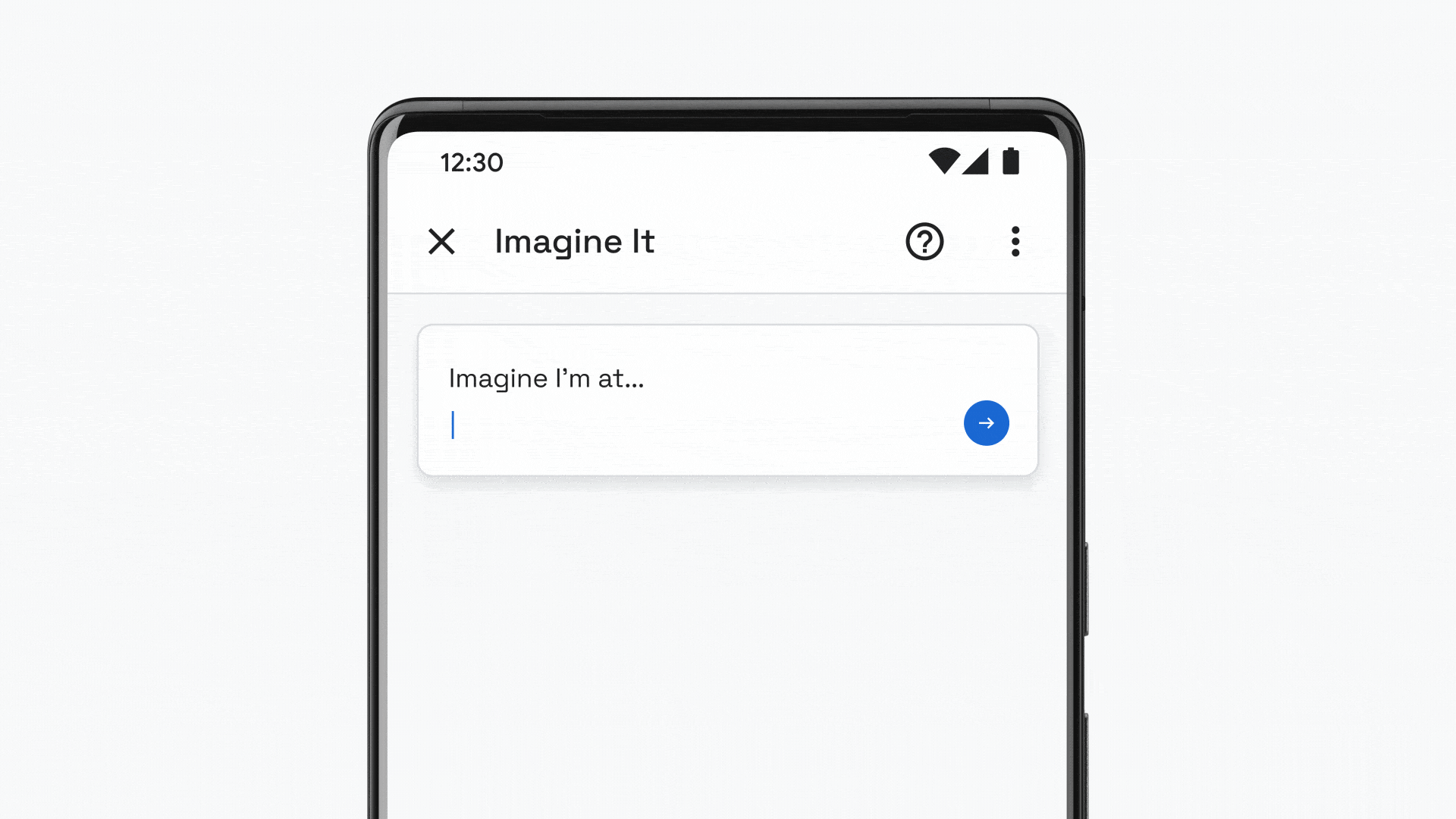
A demo of LaMDA, our generative language model for dialogue application, and the AI Test Kitchen.
We're continually working to advance our conversational capabilities. Conversation and natural language processing are powerful ways to make computers more accessible to everyone. And large language models are key to this.
Last year, we introduced LaMDA, our generative language model for dialogue applications that can converse on any topic. Today, we are excited to announce LaMDA 2, our most advanced conversational AI yet.
We are at the beginning of a journey to make models like these useful to people, and we feel a deep responsibility to get it right. To make progress, we need people to experience the technology and provide feedback. We opened LaMDA up to thousands of Googlers, who enjoyed testing it and seeing its capabilities. This yielded significant quality improvements, and led to a reduction in inaccurate or offensive responses.
That’s why we’ve made AI Test Kitchen. It’s a new way to explore AI features with a broader audience. Inside the AI Test Kitchen, there are a few different experiences. Each is meant to give you a sense of what it might be like to have LaMDA in your hands and use it for things you care about.
The first is called “Imagine it.” This demo tests if the model can take a creative idea you give it, and generate imaginative and relevant descriptions. These are not products, they are quick sketches that allow us to explore what LaMDA can do with you. The user interfaces are very simple.
Say you’re writing a story and need some inspirational ideas. Maybe one of your characters is exploring the deep ocean. You can ask what that might feel like. Here LaMDA describes a scene in the Mariana Trench. It even generates follow-up questions on the fly. You can ask LaMDA to imagine what kinds of creatures might live there. Remember, we didn’t hand-program the model for specific topics like submarines or bioluminescence. It synthesized these concepts from its training data. That’s why you can ask about almost any topic: Saturn’s rings or even being on a planet made of ice cream.
Staying on topic is a challenge for language models. Say you’re building a learning experience — you want it to be open-ended enough to allow people to explore where curiosity takes them, but stay safely on topic. Our second demo tests how LaMDA does with that.
In this demo, we’ve primed the model to focus on the topic of dogs. It starts by generating a question to spark conversation, “Have you ever wondered why dogs love to play fetch so much?” And if you ask a follow-up question, you get an answer with some relevant details: it’s interesting, it thinks it might have something to do with the sense of smell and treasure hunting.
You can take the conversation anywhere you want. Maybe you’re curious about how smell works and you want to dive deeper. You’ll get a unique response for that too. No matter what you ask, it will try to keep the conversation on the topic of dogs. If I start asking about cricket, which I probably would, the model brings the topic back to dogs in a fun way.
This challenge of staying on-topic is a tricky one, and it’s an important area of research for building useful applications with language models.
These experiences show the potential of language models to one day help us with things like planning, learning about the world, and more.
Of course, there are significant challenges to solve before these models can truly be useful. While we have improved safety, the model might still generate inaccurate, inappropriate, or offensive responses. That’s why we are inviting feedback in the app, so people can help report problems.
We will be doing all of this work in accordance with our AI Principles. Our process will be iterative, opening up access over the coming months, and carefully assessing feedback with a broad range of stakeholders — from AI researchers and social scientists to human rights experts. We’ll incorporate this feedback into future versions of LaMDA, and share our findings as we go.
Over time, we intend to continue adding other emerging areas of AI into AI Test Kitchen. You can learn more at: g.co/AITestKitchen.
Advancing AI language models
LaMDA 2 has incredible conversational capabilities. To explore other aspects of natural language processing and AI, we recently announced a new model. It’s called Pathways Language Model, or PaLM for short. It’s our largest model to date and trained on 540 billion parameters.
PaLM demonstrates breakthrough performance on many natural language processing tasks, such as generating code from text, answering a math word problem, or even explaining a joke.
It achieves this through greater scale. And when we combine that scale with a new technique called chain-of- thought prompting, the results are promising. Chain-of-thought prompting allows us to describe multi-step problems as a series of intermediate steps.
Let’s take an example of a math word problem that requires reasoning. Normally, how you use a model is you prompt it with a question and answer, and then you start asking questions. In this case: How many hours are in the month of May? So you can see, the model didn’t quite get it right.
In chain-of-thought prompting, we give the model a question-answer pair, but this time, an explanation of how the answer was derived. Kind of like when your teacher gives you a step-by-step example to help you understand how to solve a problem. Now, if we ask the model again — how many hours are in the month of May — or other related questions, it actually answers correctly and even shows its work.
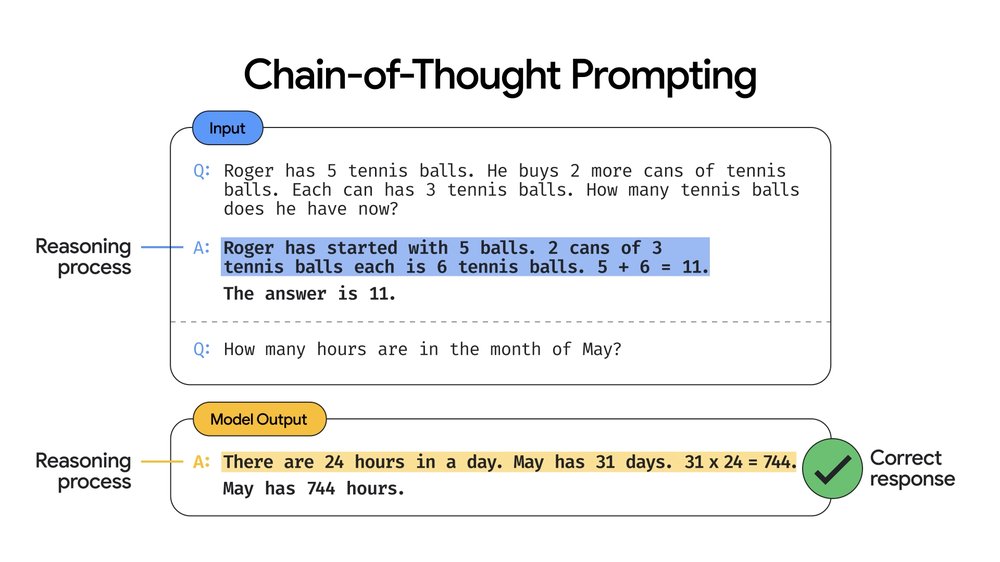
Chain-of-thought prompting leads to better reasoning and more accurate answers.
Chain-of-thought prompting increases accuracy by a large margin. This leads to state-of-the-art performance across several reasoning benchmarks, including math word problems. And we can do it all without ever changing how the model is trained.
PaLM is highly capable and can do so much more. For example, you might be someone who speaks a language that’s not well-represented on the web today — which makes it hard to find information. Even more frustrating because the answer you are looking for is probably out there. PaLM offers a new approach that holds enormous promise for making knowledge more accessible for everyone.
Let me show you an example in which we can help answer questions in a language like Bengali — spoken by a quarter billion people. Just like before we prompt the model with two examples of questions in Bengali with both Bengali and English answers.
That’s it, now we can start asking questions in Bengali: “What is the national song of Bangladesh?” The answer, by the way, is “Amar Sonar Bangla” — and PaLM got it right, too. This is not that surprising because you would expect that content to exist in Bengali.
You can also try something that is less likely to have related information in Bengali such as: “What are popular pizza toppings in New York City?” The model again answers correctly in Bengali. Though it probably just stirred up a debate amongst New Yorkers about how “correct” that answer really is.
What’s so impressive is that PaLM has never seen parallel sentences between Bengali and English. Nor was it ever explicitly taught to answer questions or translate at all! The model brought all of its capabilities together to answer questions correctly in Bengali. And we can extend the techniques to more languages and other complex tasks.
We're so optimistic about the potential for language models. One day, we hope we can answer questions on more topics in any language you speak, making knowledge even more accessible, in Search and across all of Google.
Introducing the world’s largest, publicly available machine learning hub
The advances we’ve shared today are possible only because of our continued innovation in our infrastructure. Recently we announced plans to invest $9.5 billion in data centers and offices across the U.S.
One of our state-of-the-art data centers is in Mayes County, Oklahoma. I’m excited to announce that, there, we are launching the world’s largest, publicly-available machine learning hub for our Google Cloud customers.
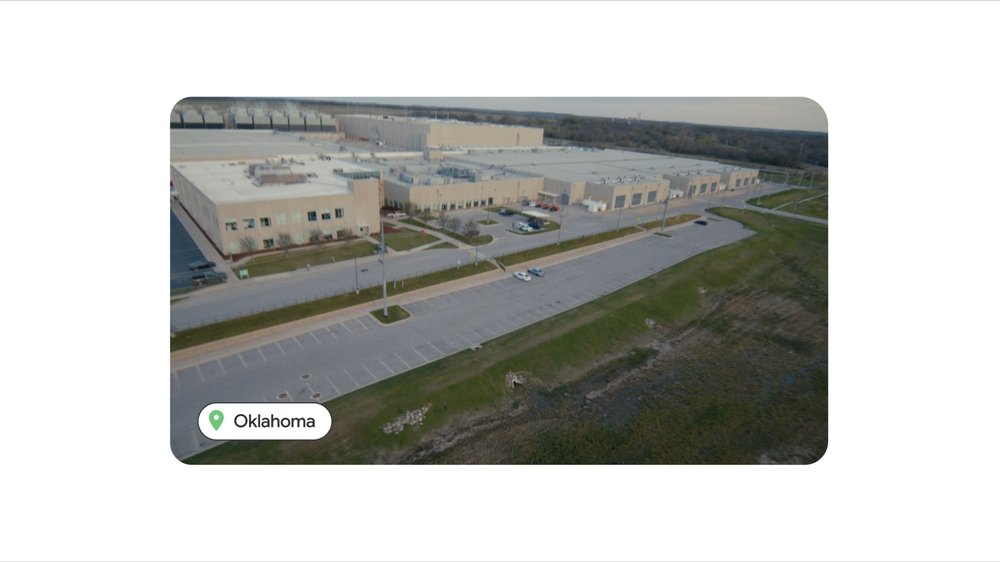
One of our state-of-the-art data centers in Mayes County, Oklahoma.
This machine learning hub has eight Cloud TPU v4 pods, custom-built on the same networking infrastructure that powers Google’s largest neural models. They provide nearly nine exaflops of computing power in aggregate — bringing our customers an unprecedented ability to run complex models and workloads. We hope this will fuel innovation across many fields, from medicine to logistics, sustainability and more.
And speaking of sustainability, this machine learning hub is already operating at 90% carbon-free energy. This is helping us make progress on our goal to become the first major company to operate all of our data centers and campuses globally on 24/7 carbon-free energy by 2030.
Even as we invest in our data centers, we are working to innovate on our mobile platforms so more processing can happen locally on device. Google Tensor, our custom system on a chip, was an important step in this direction. It’s already running on Pixel 6 and Pixel 6 Pro, and it brings our AI capabilities — including the best speech recognition we’ve ever deployed — right to your phone. It’s also a big step forward in making those devices more secure. Combined with Android’s Private Compute Core, it can run data-powered features directly on device so that it’s private to you.
People turn to our products every day for help in moments big and small. Core to making this possible is protecting your private information each step of the way. Even as technology grows increasingly complex, we keep more people safe online than anyone else in the world, with products that are secure by default, private by design and that put you in control.
We also spent time today sharing updates to platforms like Android. They’re delivering access, connectivity, and information to billions of people through their smartphones and other connected devices like TVs, cars and watches.
And we shared our new Pixel Portfolio, including the Pixel 6a, Pixel Buds Pro, Google Pixel Watch, Pixel 7, and Pixel tablet all built with ambient computing in mind. We’re excited to share a family of devices that work better together — for you.
The next frontier of computing: augmented reality
Today we talked about all the technologies that are changing how we use computers and access knowledge. We see devices working seamlessly together, exactly when and where you need them and with conversational interfaces that make it easier to get things done.
Looking ahead, there's a new frontier of computing, which has the potential to extend all of this even further, and that is augmented reality. At Google, we have been heavily invested in this area. We’ve been building augmented reality into many Google products, from Google Lens to multisearch, scene exploration, and Live and immersive views in Maps.
These AR capabilities are already useful on phones and the magic will really come alive when you can use them in the real world without the technology getting in the way.
That potential is what gets us most excited about AR: the ability to spend time focusing on what matters in the real world, in our real lives. Because the real world is pretty amazing!
It’s important we design in a way that is built for the real world — and doesn’t take you away from it. And AR gives us new ways to accomplish this.
Let’s take language as an example. Language is just so fundamental to connecting with one another. And yet, understanding someone who speaks a different language, or trying to follow a conversation if you are deaf or hard of hearing can be a real challenge. Let's see what happens when we take our advancements in translation and transcription and deliver them in your line of sight in one of the early prototypes we’ve been testing.
You can see it in their faces: the joy that comes with speaking naturally to someone. That moment of connection. To understand and be understood. That’s what our focus on knowledge and computing is all about. And it’s what we strive for every day, with products that are built to help.
Each year we get a little closer to delivering on our timeless mission. And we still have so much further to go. At Google, we genuinely feel a sense of excitement about that. And we are optimistic that the breakthroughs you just saw will help us get there. Thank you to all of the developers, partners and customers who joined us today. We look forward to building the future with all of you.


